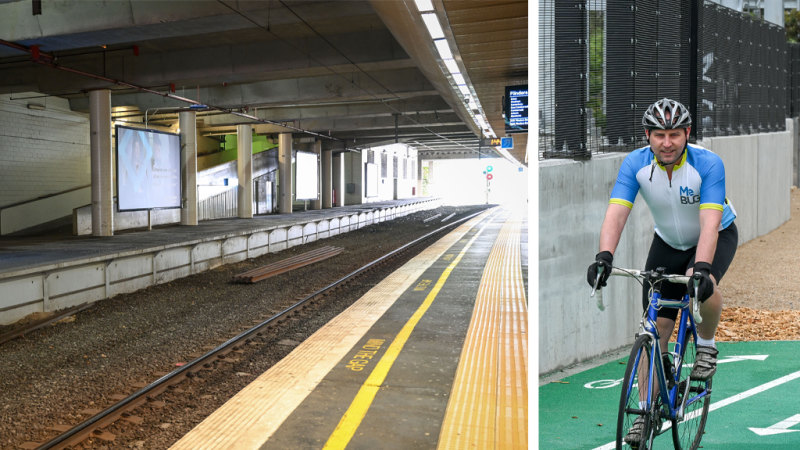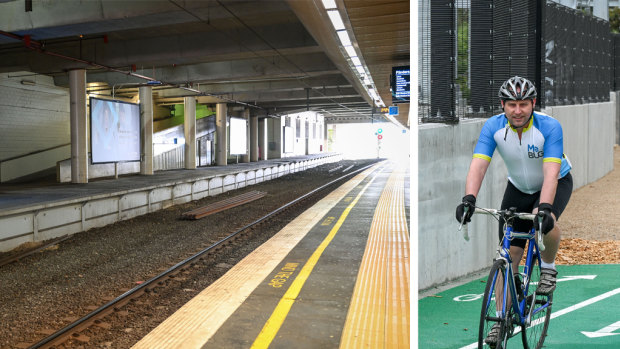Save articles for later
Add articles to your saved list and come back to them any time.
A bicycle highway through Melbourne’s eastern suburbs via an underground “ghost platform” at Box Hill station would ease road congestion and public transport crowding, according to a newly released government study that has fuelled calls to build the long-awaited project.
Federal teal MP Monique Ryan is the latest figure to throw her support behind the 10-kilometre Box Hill to Hawthorn Trail, saying people would cycle rather than drive if the critical “missing link” in Melbourne’s cycling network was built.
Box Hill Station’s “ghost platform” has been identified for a major cycleway through Melbourne’s eastern suburbs. Right: David Blom, from the David Blom, from the Hawthorn to Box Hill Trail Coalition. Credit: Eddie Jim
Boroondara and Whitehorse councils proposed the trail in 1996. Advocates say residents have no safe or direct way to travel on bikes between eastern suburbs activity centres, or from the eastern suburbs to the CBD.
Victoria’s Department of Transport (now part of the Department of Transport and Planning) published a feasibility study summary in 2021, which recommended the path should follow the existing Belgrave and Lilydale train line.
Ryan, whose Kooyong electorate covers some of the trail’s western end, last week obtained a copy of the full feasibility study through a freedom-of-information request, which presents several options for building the trail.
The study says the Box Hill-Hawthorn trail would be “likely to encourage mode shift towards cycling for shorter trips, as well as support cycling to schools, activity centres, and for recreation”, which would “reduce congestion on the wider road and public transport networks”.
The study shortlists two potential routes at Box Hill, which both involve the novel solution of turning the disused “ghost platform” at Box Hill station into an underground cycleway and bicycle parking area.
Hawthorn to Box Hill Trail Coalition spokesman David Blom said the ghost platform design would be an excellent outcome because commuters could easily access the Box Hill Central shopping centre, or transfer to trains at the existing station and the future Suburban Rail Loop station.
However, the study also says Platform 1 “may be earmarked for future redevelopment” and so might not be possible. An alternative route would divert around the station along Cambridge and Harrow Streets.
Blom said the Box Hill-Hawthorn trail would close the “biggest gap” in Melbourne’s cycling network. He commutes from Nunawading to the CBD via the Koonung Creek or Gardiners Creek trail, and estimates the new trial would shave close to six kilometres off his journey.
“It provides safe links to more than 20 schools in the area, Swinburne uni, Box Hill TAFE, and plus the major activity centres at Camberwell and Box Hill,” Blom said. “It makes commuting to the city for people who live in the middle ring to the outer east a whole lot more viable.”
One kilometre of the path has recently been built between Surrey Hills and Mont Albert as part of the Level Crossing Removal Project, while the 10-kilometre Box Hill to Ringwood trail was completed in late 2020 at a cost of $14 million.
Ryan said the study showed there were several feasible designs and no significant barriers to building the bike trail, and questioned why no progress had been made two years after the study was completed.
She called on the state government to commit to funding the project, and said it should also be considered for the Albanese government’s $150 million Urban Precincts and Partnerships Program.
“Thousands more commuters would ride to work and hundreds more students would ride to school if it was built,” she said. “For a relatively small outlay of funds… the potential benefits are very, very significant. It’s kind of a no-brainer.”
The Department of Transport and Planning and Victoria’s new Active Transport Minister, Gabrielle Williams, were contacted for comment. An Allan government spokesman said it was “examining opportunities to improve connections between Box Hill and Hawthorn”.
“While we continue to consider all options for upgrades along this corridor, we’ve been getting on with delivering more than $38 million of capital upgrades to boost safety and connectivity for bike riders since 2021,” the spokesman said.
Ryan pointed to Queensland government modelling showing that every $1 invested in cycling infrastructure delivered $5 in returns from health benefits, reduced road congestion, savings in car user costs, and reduced pollution.
Victorian government surveys have previously found that about 60 per cent of Victorians are interested in using bikes to get around but are afraid to ride alongside motor vehicle traffic.
Bicycle Network CEO Alison McCormack said thousands of people in Melbourne’s east would love the opportunity to get around on a bike, but the area has never had proper bike infrastructure.
“There has long been a need for a direct route that gets people into the city – and to the railway stations and schools along the way – and the proposed trail via the rail corridor is designed to solve this problem,” McCormack said.
“This a great opportunity for the federal government to establish its support for active transport, seize upon this soundly planned project and inject funding to bring it to fruition.”
Get the day’s breaking news, entertainment ideas and a long read to enjoy. Sign up to receive our Evening Edition newsletter here.
Most Viewed in National
From our partners
Source: Read Full Article



